NVQ5 Report: Autistic Spectrum Conditions in Health and Social Care
VerifiedAdded on 2023/01/13
|14
|4812
|47
Report
AI Summary
This NVQ5 report provides a comprehensive overview of autism spectrum conditions within the context of health and social care. It analyzes the defining features of autism, the shift from categorical to spectrum views, and controversies surrounding interventions. The report explores the implications of stereotypes and prejudice on individuals with autism, along with relevant legislation, policies, and guidance. It emphasizes the importance of a person-centered approach, focusing on individual needs, and outlines strategies for supporting communication, managing sensory difficulties, and fostering collaborative partnerships. The report also examines the influence of autism advocacy groups and their role in highlighting shortcomings in legislation, offering a well-rounded perspective on the challenges and opportunities in this field.

NVQ5 for Health and
Social Care
Table of Contents
1
Social Care
Table of Contents
1
Paraphrase This Document
Need a fresh take? Get an instant paraphrase of this document with our AI Paraphraser
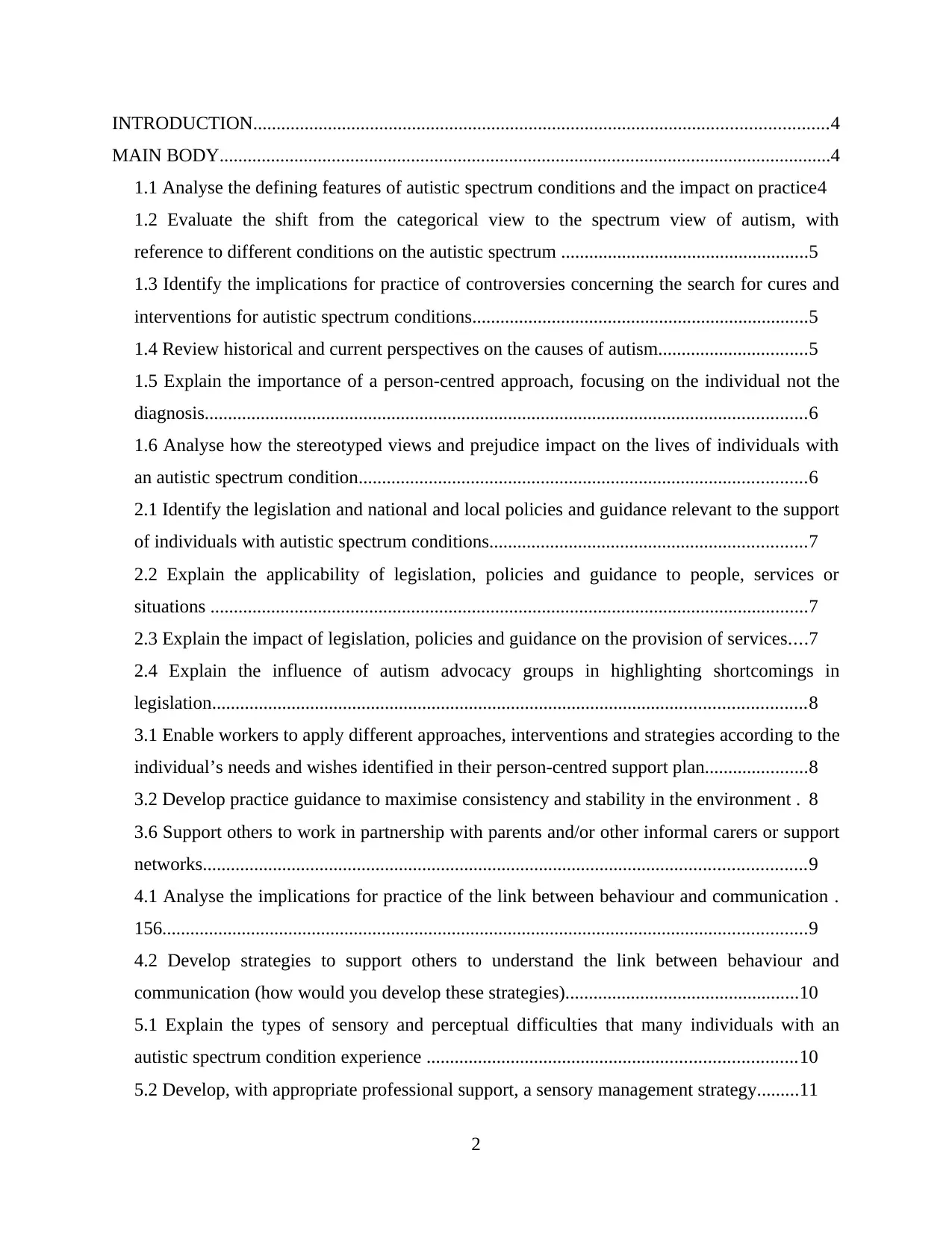
INTRODUCTION...........................................................................................................................4
MAIN BODY...................................................................................................................................4
1.1 Analyse the defining features of autistic spectrum conditions and the impact on practice4
1.2 Evaluate the shift from the categorical view to the spectrum view of autism, with
reference to different conditions on the autistic spectrum .....................................................5
1.3 Identify the implications for practice of controversies concerning the search for cures and
interventions for autistic spectrum conditions........................................................................5
1.4 Review historical and current perspectives on the causes of autism................................5
1.5 Explain the importance of a person-centred approach, focusing on the individual not the
diagnosis.................................................................................................................................6
1.6 Analyse how the stereotyped views and prejudice impact on the lives of individuals with
an autistic spectrum condition................................................................................................6
2.1 Identify the legislation and national and local policies and guidance relevant to the support
of individuals with autistic spectrum conditions....................................................................7
2.2 Explain the applicability of legislation, policies and guidance to people, services or
situations ................................................................................................................................7
2.3 Explain the impact of legislation, policies and guidance on the provision of services....7
2.4 Explain the influence of autism advocacy groups in highlighting shortcomings in
legislation...............................................................................................................................8
3.1 Enable workers to apply different approaches, interventions and strategies according to the
individual’s needs and wishes identified in their person-centred support plan......................8
3.2 Develop practice guidance to maximise consistency and stability in the environment . 8
3.6 Support others to work in partnership with parents and/or other informal carers or support
networks.................................................................................................................................9
4.1 Analyse the implications for practice of the link between behaviour and communication .
156..........................................................................................................................................9
4.2 Develop strategies to support others to understand the link between behaviour and
communication (how would you develop these strategies)..................................................10
5.1 Explain the types of sensory and perceptual difficulties that many individuals with an
autistic spectrum condition experience ...............................................................................10
5.2 Develop, with appropriate professional support, a sensory management strategy.........11
2
MAIN BODY...................................................................................................................................4
1.1 Analyse the defining features of autistic spectrum conditions and the impact on practice4
1.2 Evaluate the shift from the categorical view to the spectrum view of autism, with
reference to different conditions on the autistic spectrum .....................................................5
1.3 Identify the implications for practice of controversies concerning the search for cures and
interventions for autistic spectrum conditions........................................................................5
1.4 Review historical and current perspectives on the causes of autism................................5
1.5 Explain the importance of a person-centred approach, focusing on the individual not the
diagnosis.................................................................................................................................6
1.6 Analyse how the stereotyped views and prejudice impact on the lives of individuals with
an autistic spectrum condition................................................................................................6
2.1 Identify the legislation and national and local policies and guidance relevant to the support
of individuals with autistic spectrum conditions....................................................................7
2.2 Explain the applicability of legislation, policies and guidance to people, services or
situations ................................................................................................................................7
2.3 Explain the impact of legislation, policies and guidance on the provision of services....7
2.4 Explain the influence of autism advocacy groups in highlighting shortcomings in
legislation...............................................................................................................................8
3.1 Enable workers to apply different approaches, interventions and strategies according to the
individual’s needs and wishes identified in their person-centred support plan......................8
3.2 Develop practice guidance to maximise consistency and stability in the environment . 8
3.6 Support others to work in partnership with parents and/or other informal carers or support
networks.................................................................................................................................9
4.1 Analyse the implications for practice of the link between behaviour and communication .
156..........................................................................................................................................9
4.2 Develop strategies to support others to understand the link between behaviour and
communication (how would you develop these strategies)..................................................10
5.1 Explain the types of sensory and perceptual difficulties that many individuals with an
autistic spectrum condition experience ...............................................................................10
5.2 Develop, with appropriate professional support, a sensory management strategy.........11
2
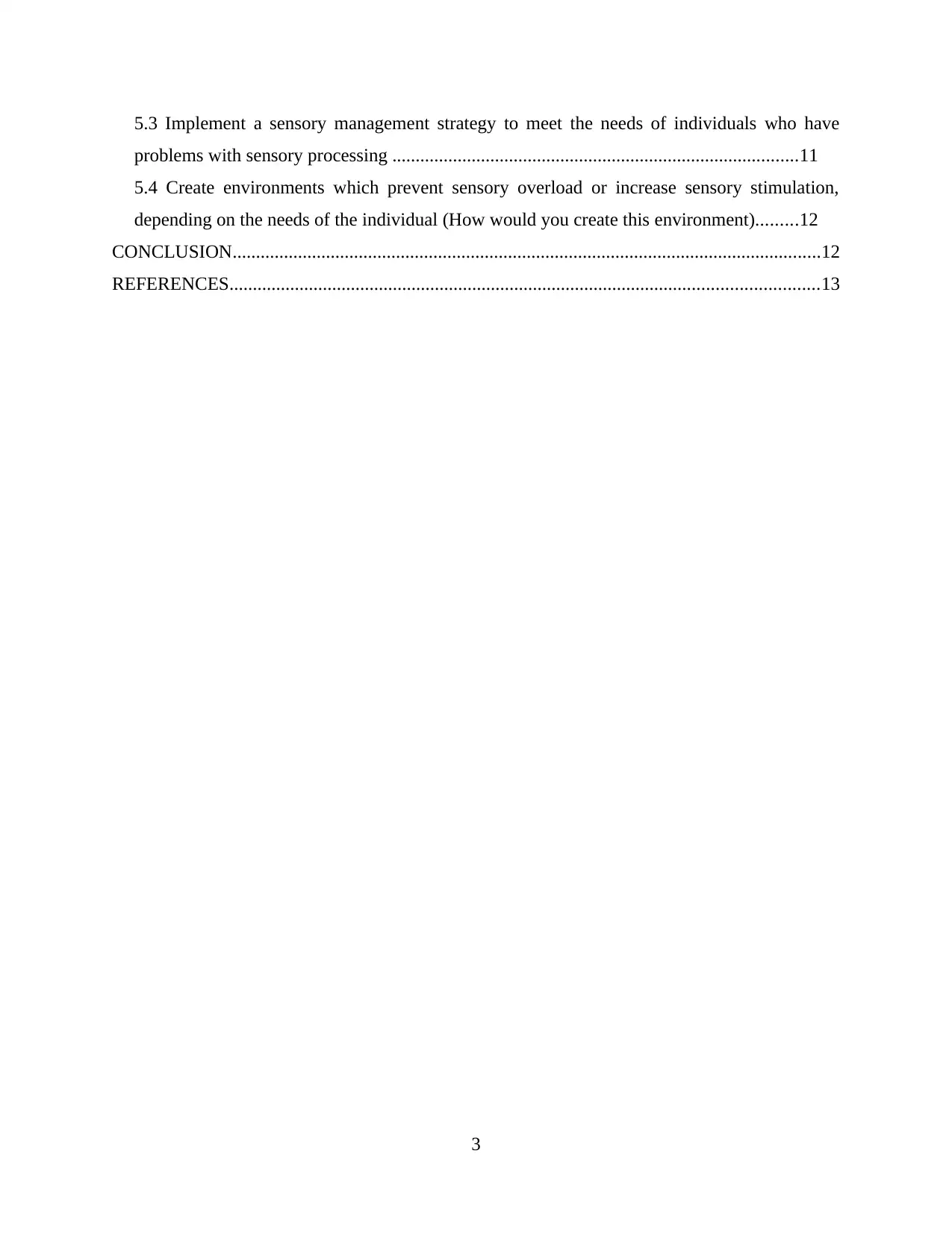
5.3 Implement a sensory management strategy to meet the needs of individuals who have
problems with sensory processing .......................................................................................11
5.4 Create environments which prevent sensory overload or increase sensory stimulation,
depending on the needs of the individual (How would you create this environment).........12
CONCLUSION..............................................................................................................................12
REFERENCES..............................................................................................................................13
3
problems with sensory processing .......................................................................................11
5.4 Create environments which prevent sensory overload or increase sensory stimulation,
depending on the needs of the individual (How would you create this environment).........12
CONCLUSION..............................................................................................................................12
REFERENCES..............................................................................................................................13
3
⊘ This is a preview!⊘
Do you want full access?
Subscribe today to unlock all pages.

Trusted by 1+ million students worldwide
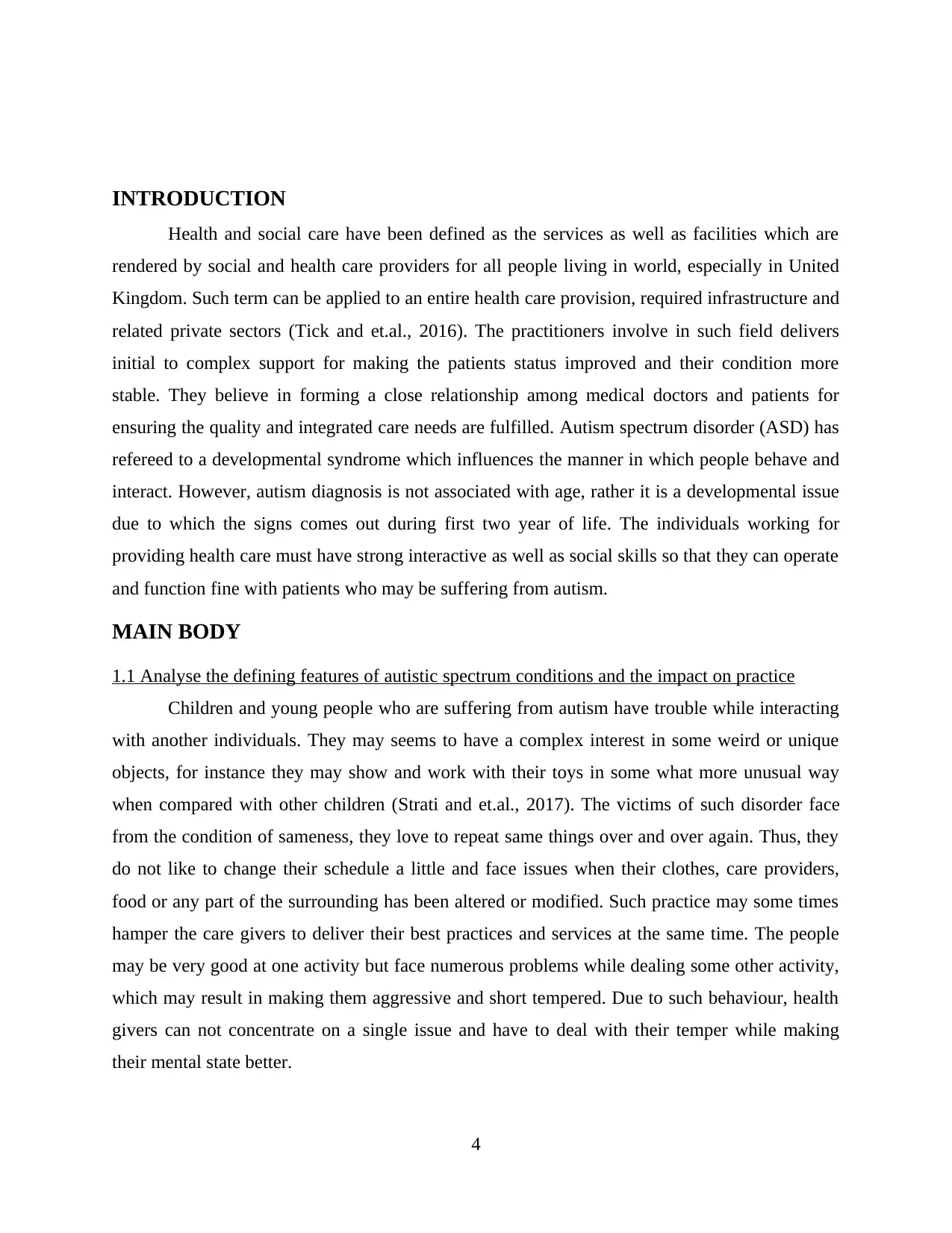
INTRODUCTION
Health and social care have been defined as the services as well as facilities which are
rendered by social and health care providers for all people living in world, especially in United
Kingdom. Such term can be applied to an entire health care provision, required infrastructure and
related private sectors (Tick and et.al., 2016). The practitioners involve in such field delivers
initial to complex support for making the patients status improved and their condition more
stable. They believe in forming a close relationship among medical doctors and patients for
ensuring the quality and integrated care needs are fulfilled. Autism spectrum disorder (ASD) has
refereed to a developmental syndrome which influences the manner in which people behave and
interact. However, autism diagnosis is not associated with age, rather it is a developmental issue
due to which the signs comes out during first two year of life. The individuals working for
providing health care must have strong interactive as well as social skills so that they can operate
and function fine with patients who may be suffering from autism.
MAIN BODY
1.1 Analyse the defining features of autistic spectrum conditions and the impact on practice
Children and young people who are suffering from autism have trouble while interacting
with another individuals. They may seems to have a complex interest in some weird or unique
objects, for instance they may show and work with their toys in some what more unusual way
when compared with other children (Strati and et.al., 2017). The victims of such disorder face
from the condition of sameness, they love to repeat same things over and over again. Thus, they
do not like to change their schedule a little and face issues when their clothes, care providers,
food or any part of the surrounding has been altered or modified. Such practice may some times
hamper the care givers to deliver their best practices and services at the same time. The people
may be very good at one activity but face numerous problems while dealing some other activity,
which may result in making them aggressive and short tempered. Due to such behaviour, health
givers can not concentrate on a single issue and have to deal with their temper while making
their mental state better.
4
Health and social care have been defined as the services as well as facilities which are
rendered by social and health care providers for all people living in world, especially in United
Kingdom. Such term can be applied to an entire health care provision, required infrastructure and
related private sectors (Tick and et.al., 2016). The practitioners involve in such field delivers
initial to complex support for making the patients status improved and their condition more
stable. They believe in forming a close relationship among medical doctors and patients for
ensuring the quality and integrated care needs are fulfilled. Autism spectrum disorder (ASD) has
refereed to a developmental syndrome which influences the manner in which people behave and
interact. However, autism diagnosis is not associated with age, rather it is a developmental issue
due to which the signs comes out during first two year of life. The individuals working for
providing health care must have strong interactive as well as social skills so that they can operate
and function fine with patients who may be suffering from autism.
MAIN BODY
1.1 Analyse the defining features of autistic spectrum conditions and the impact on practice
Children and young people who are suffering from autism have trouble while interacting
with another individuals. They may seems to have a complex interest in some weird or unique
objects, for instance they may show and work with their toys in some what more unusual way
when compared with other children (Strati and et.al., 2017). The victims of such disorder face
from the condition of sameness, they love to repeat same things over and over again. Thus, they
do not like to change their schedule a little and face issues when their clothes, care providers,
food or any part of the surrounding has been altered or modified. Such practice may some times
hamper the care givers to deliver their best practices and services at the same time. The people
may be very good at one activity but face numerous problems while dealing some other activity,
which may result in making them aggressive and short tempered. Due to such behaviour, health
givers can not concentrate on a single issue and have to deal with their temper while making
their mental state better.
4
Paraphrase This Document
Need a fresh take? Get an instant paraphrase of this document with our AI Paraphraser
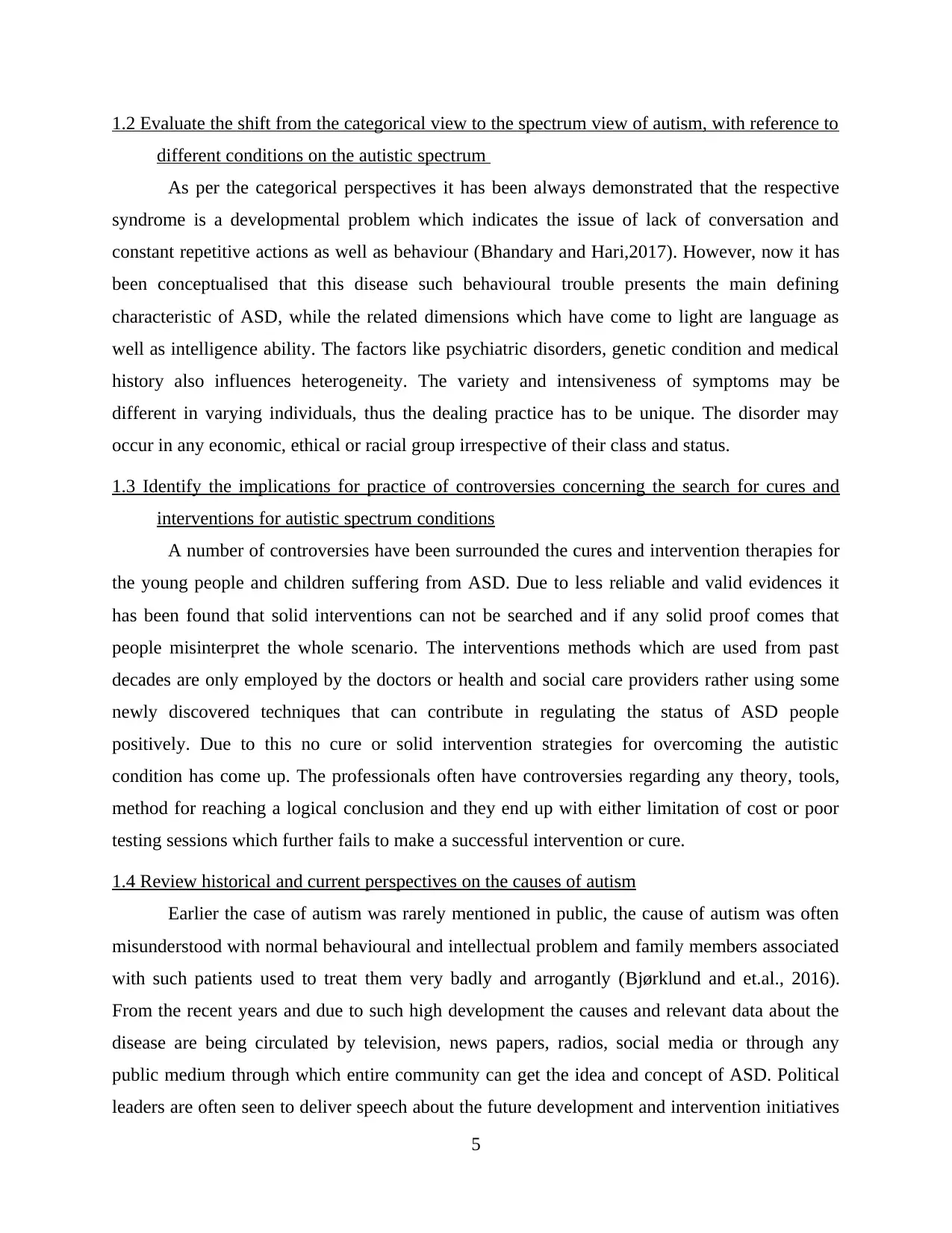
1.2 Evaluate the shift from the categorical view to the spectrum view of autism, with reference to
different conditions on the autistic spectrum
As per the categorical perspectives it has been always demonstrated that the respective
syndrome is a developmental problem which indicates the issue of lack of conversation and
constant repetitive actions as well as behaviour (Bhandary and Hari,2017). However, now it has
been conceptualised that this disease such behavioural trouble presents the main defining
characteristic of ASD, while the related dimensions which have come to light are language as
well as intelligence ability. The factors like psychiatric disorders, genetic condition and medical
history also influences heterogeneity. The variety and intensiveness of symptoms may be
different in varying individuals, thus the dealing practice has to be unique. The disorder may
occur in any economic, ethical or racial group irrespective of their class and status.
1.3 Identify the implications for practice of controversies concerning the search for cures and
interventions for autistic spectrum conditions
A number of controversies have been surrounded the cures and intervention therapies for
the young people and children suffering from ASD. Due to less reliable and valid evidences it
has been found that solid interventions can not be searched and if any solid proof comes that
people misinterpret the whole scenario. The interventions methods which are used from past
decades are only employed by the doctors or health and social care providers rather using some
newly discovered techniques that can contribute in regulating the status of ASD people
positively. Due to this no cure or solid intervention strategies for overcoming the autistic
condition has come up. The professionals often have controversies regarding any theory, tools,
method for reaching a logical conclusion and they end up with either limitation of cost or poor
testing sessions which further fails to make a successful intervention or cure.
1.4 Review historical and current perspectives on the causes of autism
Earlier the case of autism was rarely mentioned in public, the cause of autism was often
misunderstood with normal behavioural and intellectual problem and family members associated
with such patients used to treat them very badly and arrogantly (Bjørklund and et.al., 2016).
From the recent years and due to such high development the causes and relevant data about the
disease are being circulated by television, news papers, radios, social media or through any
public medium through which entire community can get the idea and concept of ASD. Political
leaders are often seen to deliver speech about the future development and intervention initiatives
5
different conditions on the autistic spectrum
As per the categorical perspectives it has been always demonstrated that the respective
syndrome is a developmental problem which indicates the issue of lack of conversation and
constant repetitive actions as well as behaviour (Bhandary and Hari,2017). However, now it has
been conceptualised that this disease such behavioural trouble presents the main defining
characteristic of ASD, while the related dimensions which have come to light are language as
well as intelligence ability. The factors like psychiatric disorders, genetic condition and medical
history also influences heterogeneity. The variety and intensiveness of symptoms may be
different in varying individuals, thus the dealing practice has to be unique. The disorder may
occur in any economic, ethical or racial group irrespective of their class and status.
1.3 Identify the implications for practice of controversies concerning the search for cures and
interventions for autistic spectrum conditions
A number of controversies have been surrounded the cures and intervention therapies for
the young people and children suffering from ASD. Due to less reliable and valid evidences it
has been found that solid interventions can not be searched and if any solid proof comes that
people misinterpret the whole scenario. The interventions methods which are used from past
decades are only employed by the doctors or health and social care providers rather using some
newly discovered techniques that can contribute in regulating the status of ASD people
positively. Due to this no cure or solid intervention strategies for overcoming the autistic
condition has come up. The professionals often have controversies regarding any theory, tools,
method for reaching a logical conclusion and they end up with either limitation of cost or poor
testing sessions which further fails to make a successful intervention or cure.
1.4 Review historical and current perspectives on the causes of autism
Earlier the case of autism was rarely mentioned in public, the cause of autism was often
misunderstood with normal behavioural and intellectual problem and family members associated
with such patients used to treat them very badly and arrogantly (Bjørklund and et.al., 2016).
From the recent years and due to such high development the causes and relevant data about the
disease are being circulated by television, news papers, radios, social media or through any
public medium through which entire community can get the idea and concept of ASD. Political
leaders are often seen to deliver speech about the future development and intervention initiatives
5
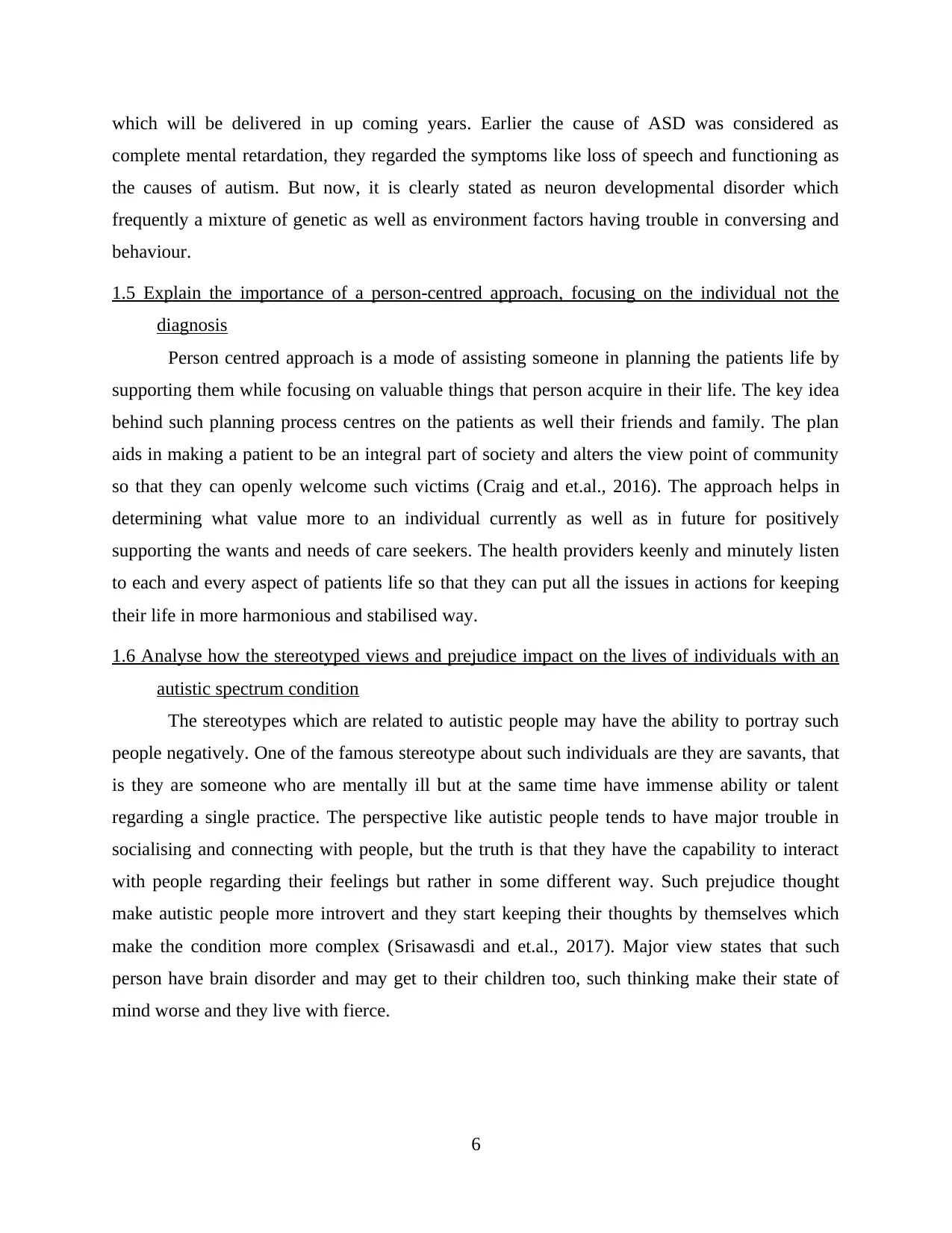
which will be delivered in up coming years. Earlier the cause of ASD was considered as
complete mental retardation, they regarded the symptoms like loss of speech and functioning as
the causes of autism. But now, it is clearly stated as neuron developmental disorder which
frequently a mixture of genetic as well as environment factors having trouble in conversing and
behaviour.
1.5 Explain the importance of a person-centred approach, focusing on the individual not the
diagnosis
Person centred approach is a mode of assisting someone in planning the patients life by
supporting them while focusing on valuable things that person acquire in their life. The key idea
behind such planning process centres on the patients as well their friends and family. The plan
aids in making a patient to be an integral part of society and alters the view point of community
so that they can openly welcome such victims (Craig and et.al., 2016). The approach helps in
determining what value more to an individual currently as well as in future for positively
supporting the wants and needs of care seekers. The health providers keenly and minutely listen
to each and every aspect of patients life so that they can put all the issues in actions for keeping
their life in more harmonious and stabilised way.
1.6 Analyse how the stereotyped views and prejudice impact on the lives of individuals with an
autistic spectrum condition
The stereotypes which are related to autistic people may have the ability to portray such
people negatively. One of the famous stereotype about such individuals are they are savants, that
is they are someone who are mentally ill but at the same time have immense ability or talent
regarding a single practice. The perspective like autistic people tends to have major trouble in
socialising and connecting with people, but the truth is that they have the capability to interact
with people regarding their feelings but rather in some different way. Such prejudice thought
make autistic people more introvert and they start keeping their thoughts by themselves which
make the condition more complex (Srisawasdi and et.al., 2017). Major view states that such
person have brain disorder and may get to their children too, such thinking make their state of
mind worse and they live with fierce.
6
complete mental retardation, they regarded the symptoms like loss of speech and functioning as
the causes of autism. But now, it is clearly stated as neuron developmental disorder which
frequently a mixture of genetic as well as environment factors having trouble in conversing and
behaviour.
1.5 Explain the importance of a person-centred approach, focusing on the individual not the
diagnosis
Person centred approach is a mode of assisting someone in planning the patients life by
supporting them while focusing on valuable things that person acquire in their life. The key idea
behind such planning process centres on the patients as well their friends and family. The plan
aids in making a patient to be an integral part of society and alters the view point of community
so that they can openly welcome such victims (Craig and et.al., 2016). The approach helps in
determining what value more to an individual currently as well as in future for positively
supporting the wants and needs of care seekers. The health providers keenly and minutely listen
to each and every aspect of patients life so that they can put all the issues in actions for keeping
their life in more harmonious and stabilised way.
1.6 Analyse how the stereotyped views and prejudice impact on the lives of individuals with an
autistic spectrum condition
The stereotypes which are related to autistic people may have the ability to portray such
people negatively. One of the famous stereotype about such individuals are they are savants, that
is they are someone who are mentally ill but at the same time have immense ability or talent
regarding a single practice. The perspective like autistic people tends to have major trouble in
socialising and connecting with people, but the truth is that they have the capability to interact
with people regarding their feelings but rather in some different way. Such prejudice thought
make autistic people more introvert and they start keeping their thoughts by themselves which
make the condition more complex (Srisawasdi and et.al., 2017). Major view states that such
person have brain disorder and may get to their children too, such thinking make their state of
mind worse and they live with fierce.
6
⊘ This is a preview!⊘
Do you want full access?
Subscribe today to unlock all pages.

Trusted by 1+ million students worldwide
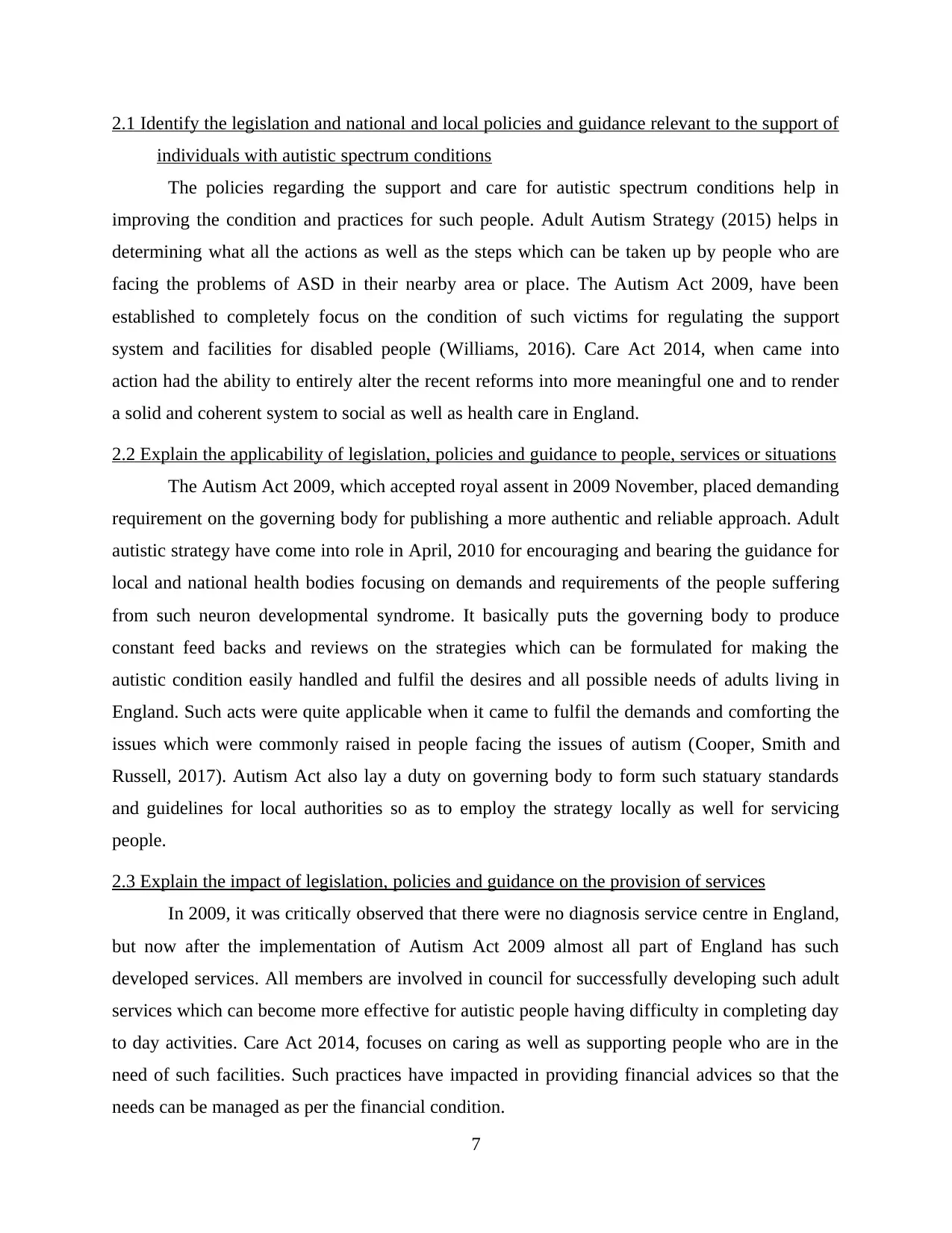
2.1 Identify the legislation and national and local policies and guidance relevant to the support of
individuals with autistic spectrum conditions
The policies regarding the support and care for autistic spectrum conditions help in
improving the condition and practices for such people. Adult Autism Strategy (2015) helps in
determining what all the actions as well as the steps which can be taken up by people who are
facing the problems of ASD in their nearby area or place. The Autism Act 2009, have been
established to completely focus on the condition of such victims for regulating the support
system and facilities for disabled people (Williams, 2016). Care Act 2014, when came into
action had the ability to entirely alter the recent reforms into more meaningful one and to render
a solid and coherent system to social as well as health care in England.
2.2 Explain the applicability of legislation, policies and guidance to people, services or situations
The Autism Act 2009, which accepted royal assent in 2009 November, placed demanding
requirement on the governing body for publishing a more authentic and reliable approach. Adult
autistic strategy have come into role in April, 2010 for encouraging and bearing the guidance for
local and national health bodies focusing on demands and requirements of the people suffering
from such neuron developmental syndrome. It basically puts the governing body to produce
constant feed backs and reviews on the strategies which can be formulated for making the
autistic condition easily handled and fulfil the desires and all possible needs of adults living in
England. Such acts were quite applicable when it came to fulfil the demands and comforting the
issues which were commonly raised in people facing the issues of autism (Cooper, Smith and
Russell, 2017). Autism Act also lay a duty on governing body to form such statuary standards
and guidelines for local authorities so as to employ the strategy locally as well for servicing
people.
2.3 Explain the impact of legislation, policies and guidance on the provision of services
In 2009, it was critically observed that there were no diagnosis service centre in England,
but now after the implementation of Autism Act 2009 almost all part of England has such
developed services. All members are involved in council for successfully developing such adult
services which can become more effective for autistic people having difficulty in completing day
to day activities. Care Act 2014, focuses on caring as well as supporting people who are in the
need of such facilities. Such practices have impacted in providing financial advices so that the
needs can be managed as per the financial condition.
7
individuals with autistic spectrum conditions
The policies regarding the support and care for autistic spectrum conditions help in
improving the condition and practices for such people. Adult Autism Strategy (2015) helps in
determining what all the actions as well as the steps which can be taken up by people who are
facing the problems of ASD in their nearby area or place. The Autism Act 2009, have been
established to completely focus on the condition of such victims for regulating the support
system and facilities for disabled people (Williams, 2016). Care Act 2014, when came into
action had the ability to entirely alter the recent reforms into more meaningful one and to render
a solid and coherent system to social as well as health care in England.
2.2 Explain the applicability of legislation, policies and guidance to people, services or situations
The Autism Act 2009, which accepted royal assent in 2009 November, placed demanding
requirement on the governing body for publishing a more authentic and reliable approach. Adult
autistic strategy have come into role in April, 2010 for encouraging and bearing the guidance for
local and national health bodies focusing on demands and requirements of the people suffering
from such neuron developmental syndrome. It basically puts the governing body to produce
constant feed backs and reviews on the strategies which can be formulated for making the
autistic condition easily handled and fulfil the desires and all possible needs of adults living in
England. Such acts were quite applicable when it came to fulfil the demands and comforting the
issues which were commonly raised in people facing the issues of autism (Cooper, Smith and
Russell, 2017). Autism Act also lay a duty on governing body to form such statuary standards
and guidelines for local authorities so as to employ the strategy locally as well for servicing
people.
2.3 Explain the impact of legislation, policies and guidance on the provision of services
In 2009, it was critically observed that there were no diagnosis service centre in England,
but now after the implementation of Autism Act 2009 almost all part of England has such
developed services. All members are involved in council for successfully developing such adult
services which can become more effective for autistic people having difficulty in completing day
to day activities. Care Act 2014, focuses on caring as well as supporting people who are in the
need of such facilities. Such practices have impacted in providing financial advices so that the
needs can be managed as per the financial condition.
7
Paraphrase This Document
Need a fresh take? Get an instant paraphrase of this document with our AI Paraphraser
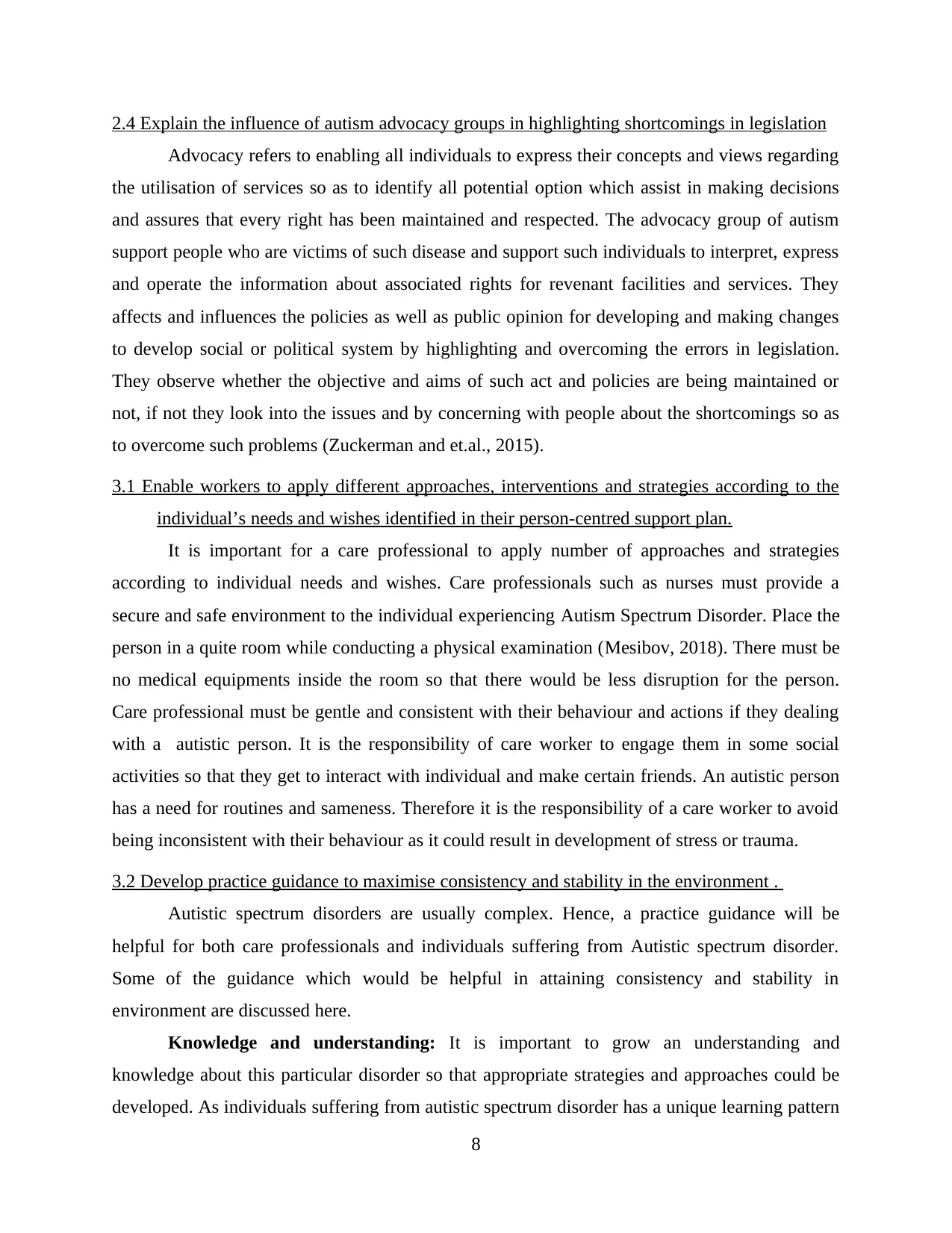
2.4 Explain the influence of autism advocacy groups in highlighting shortcomings in legislation
Advocacy refers to enabling all individuals to express their concepts and views regarding
the utilisation of services so as to identify all potential option which assist in making decisions
and assures that every right has been maintained and respected. The advocacy group of autism
support people who are victims of such disease and support such individuals to interpret, express
and operate the information about associated rights for revenant facilities and services. They
affects and influences the policies as well as public opinion for developing and making changes
to develop social or political system by highlighting and overcoming the errors in legislation.
They observe whether the objective and aims of such act and policies are being maintained or
not, if not they look into the issues and by concerning with people about the shortcomings so as
to overcome such problems (Zuckerman and et.al., 2015).
3.1 Enable workers to apply different approaches, interventions and strategies according to the
individual’s needs and wishes identified in their person-centred support plan.
It is important for a care professional to apply number of approaches and strategies
according to individual needs and wishes. Care professionals such as nurses must provide a
secure and safe environment to the individual experiencing Autism Spectrum Disorder. Place the
person in a quite room while conducting a physical examination (Mesibov, 2018). There must be
no medical equipments inside the room so that there would be less disruption for the person.
Care professional must be gentle and consistent with their behaviour and actions if they dealing
with a autistic person. It is the responsibility of care worker to engage them in some social
activities so that they get to interact with individual and make certain friends. An autistic person
has a need for routines and sameness. Therefore it is the responsibility of a care worker to avoid
being inconsistent with their behaviour as it could result in development of stress or trauma.
3.2 Develop practice guidance to maximise consistency and stability in the environment .
Autistic spectrum disorders are usually complex. Hence, a practice guidance will be
helpful for both care professionals and individuals suffering from Autistic spectrum disorder.
Some of the guidance which would be helpful in attaining consistency and stability in
environment are discussed here.
Knowledge and understanding: It is important to grow an understanding and
knowledge about this particular disorder so that appropriate strategies and approaches could be
developed. As individuals suffering from autistic spectrum disorder has a unique learning pattern
8
Advocacy refers to enabling all individuals to express their concepts and views regarding
the utilisation of services so as to identify all potential option which assist in making decisions
and assures that every right has been maintained and respected. The advocacy group of autism
support people who are victims of such disease and support such individuals to interpret, express
and operate the information about associated rights for revenant facilities and services. They
affects and influences the policies as well as public opinion for developing and making changes
to develop social or political system by highlighting and overcoming the errors in legislation.
They observe whether the objective and aims of such act and policies are being maintained or
not, if not they look into the issues and by concerning with people about the shortcomings so as
to overcome such problems (Zuckerman and et.al., 2015).
3.1 Enable workers to apply different approaches, interventions and strategies according to the
individual’s needs and wishes identified in their person-centred support plan.
It is important for a care professional to apply number of approaches and strategies
according to individual needs and wishes. Care professionals such as nurses must provide a
secure and safe environment to the individual experiencing Autism Spectrum Disorder. Place the
person in a quite room while conducting a physical examination (Mesibov, 2018). There must be
no medical equipments inside the room so that there would be less disruption for the person.
Care professional must be gentle and consistent with their behaviour and actions if they dealing
with a autistic person. It is the responsibility of care worker to engage them in some social
activities so that they get to interact with individual and make certain friends. An autistic person
has a need for routines and sameness. Therefore it is the responsibility of a care worker to avoid
being inconsistent with their behaviour as it could result in development of stress or trauma.
3.2 Develop practice guidance to maximise consistency and stability in the environment .
Autistic spectrum disorders are usually complex. Hence, a practice guidance will be
helpful for both care professionals and individuals suffering from Autistic spectrum disorder.
Some of the guidance which would be helpful in attaining consistency and stability in
environment are discussed here.
Knowledge and understanding: It is important to grow an understanding and
knowledge about this particular disorder so that appropriate strategies and approaches could be
developed. As individuals suffering from autistic spectrum disorder has a unique learning pattern
8
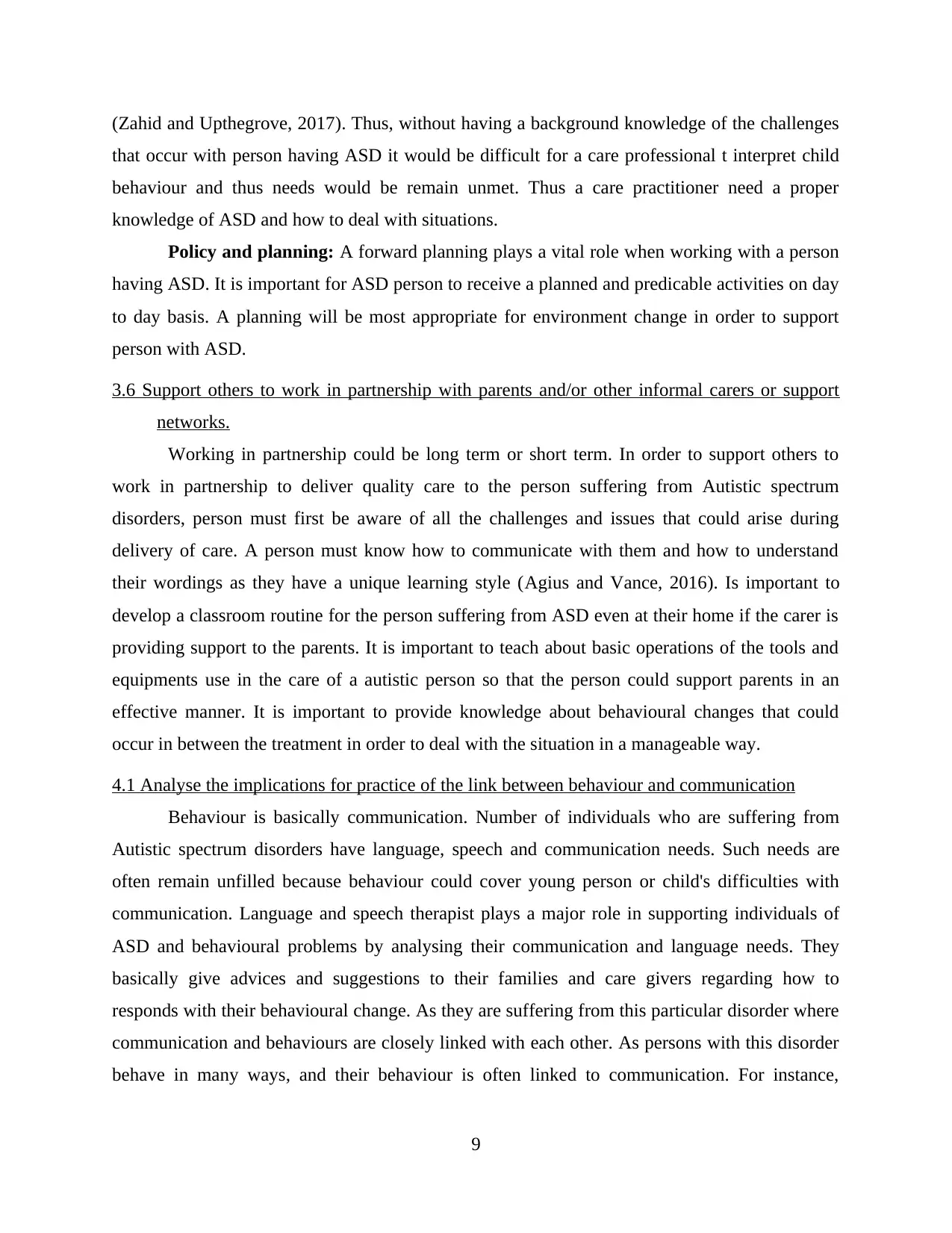
(Zahid and Upthegrove, 2017). Thus, without having a background knowledge of the challenges
that occur with person having ASD it would be difficult for a care professional t interpret child
behaviour and thus needs would be remain unmet. Thus a care practitioner need a proper
knowledge of ASD and how to deal with situations.
Policy and planning: A forward planning plays a vital role when working with a person
having ASD. It is important for ASD person to receive a planned and predicable activities on day
to day basis. A planning will be most appropriate for environment change in order to support
person with ASD.
3.6 Support others to work in partnership with parents and/or other informal carers or support
networks.
Working in partnership could be long term or short term. In order to support others to
work in partnership to deliver quality care to the person suffering from Autistic spectrum
disorders, person must first be aware of all the challenges and issues that could arise during
delivery of care. A person must know how to communicate with them and how to understand
their wordings as they have a unique learning style (Agius and Vance, 2016). Is important to
develop a classroom routine for the person suffering from ASD even at their home if the carer is
providing support to the parents. It is important to teach about basic operations of the tools and
equipments use in the care of a autistic person so that the person could support parents in an
effective manner. It is important to provide knowledge about behavioural changes that could
occur in between the treatment in order to deal with the situation in a manageable way.
4.1 Analyse the implications for practice of the link between behaviour and communication
Behaviour is basically communication. Number of individuals who are suffering from
Autistic spectrum disorders have language, speech and communication needs. Such needs are
often remain unfilled because behaviour could cover young person or child's difficulties with
communication. Language and speech therapist plays a major role in supporting individuals of
ASD and behavioural problems by analysing their communication and language needs. They
basically give advices and suggestions to their families and care givers regarding how to
responds with their behavioural change. As they are suffering from this particular disorder where
communication and behaviours are closely linked with each other. As persons with this disorder
behave in many ways, and their behaviour is often linked to communication. For instance,
9
that occur with person having ASD it would be difficult for a care professional t interpret child
behaviour and thus needs would be remain unmet. Thus a care practitioner need a proper
knowledge of ASD and how to deal with situations.
Policy and planning: A forward planning plays a vital role when working with a person
having ASD. It is important for ASD person to receive a planned and predicable activities on day
to day basis. A planning will be most appropriate for environment change in order to support
person with ASD.
3.6 Support others to work in partnership with parents and/or other informal carers or support
networks.
Working in partnership could be long term or short term. In order to support others to
work in partnership to deliver quality care to the person suffering from Autistic spectrum
disorders, person must first be aware of all the challenges and issues that could arise during
delivery of care. A person must know how to communicate with them and how to understand
their wordings as they have a unique learning style (Agius and Vance, 2016). Is important to
develop a classroom routine for the person suffering from ASD even at their home if the carer is
providing support to the parents. It is important to teach about basic operations of the tools and
equipments use in the care of a autistic person so that the person could support parents in an
effective manner. It is important to provide knowledge about behavioural changes that could
occur in between the treatment in order to deal with the situation in a manageable way.
4.1 Analyse the implications for practice of the link between behaviour and communication
Behaviour is basically communication. Number of individuals who are suffering from
Autistic spectrum disorders have language, speech and communication needs. Such needs are
often remain unfilled because behaviour could cover young person or child's difficulties with
communication. Language and speech therapist plays a major role in supporting individuals of
ASD and behavioural problems by analysing their communication and language needs. They
basically give advices and suggestions to their families and care givers regarding how to
responds with their behavioural change. As they are suffering from this particular disorder where
communication and behaviours are closely linked with each other. As persons with this disorder
behave in many ways, and their behaviour is often linked to communication. For instance,
9
⊘ This is a preview!⊘
Do you want full access?
Subscribe today to unlock all pages.

Trusted by 1+ million students worldwide
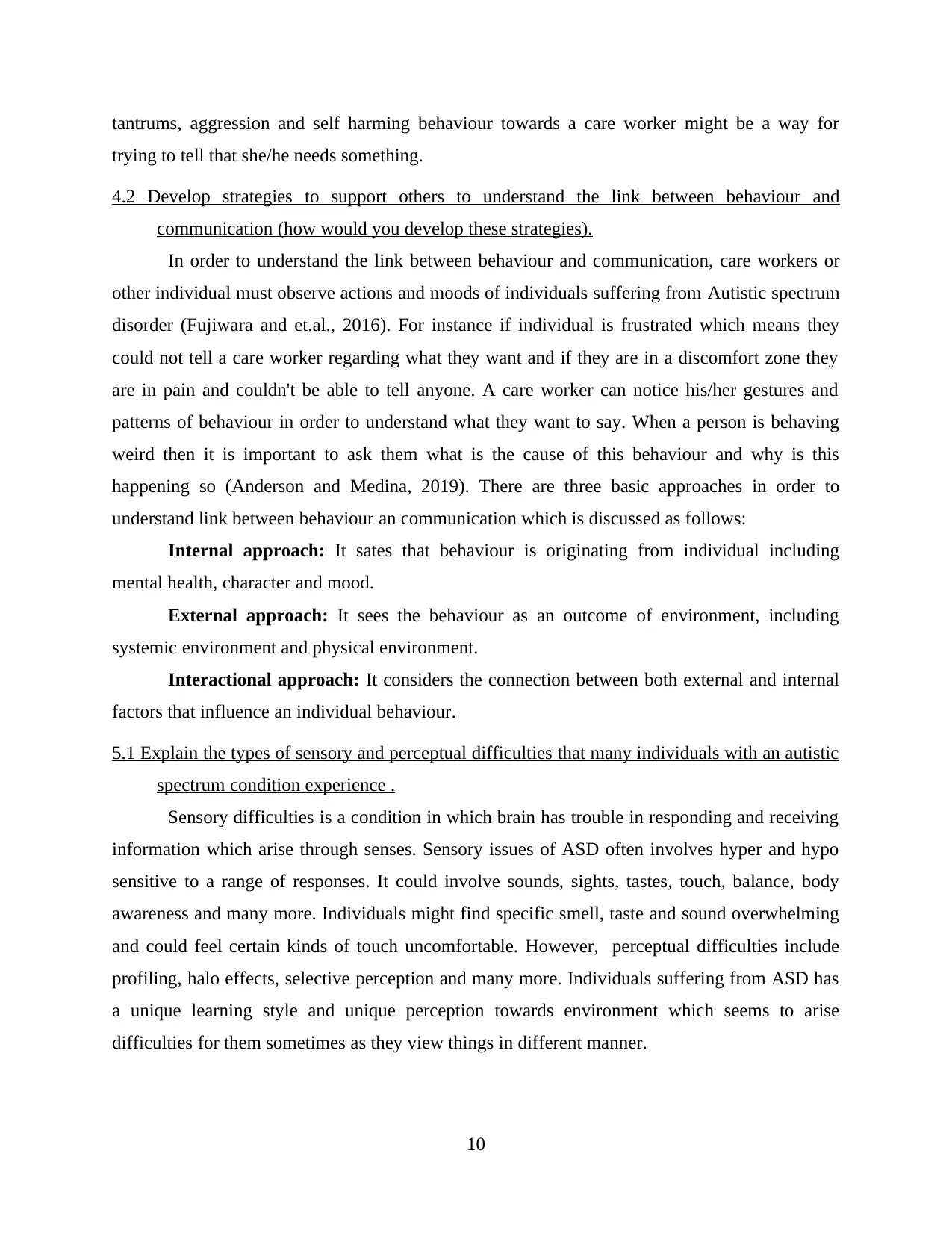
tantrums, aggression and self harming behaviour towards a care worker might be a way for
trying to tell that she/he needs something.
4.2 Develop strategies to support others to understand the link between behaviour and
communication (how would you develop these strategies).
In order to understand the link between behaviour and communication, care workers or
other individual must observe actions and moods of individuals suffering from Autistic spectrum
disorder (Fujiwara and et.al., 2016). For instance if individual is frustrated which means they
could not tell a care worker regarding what they want and if they are in a discomfort zone they
are in pain and couldn't be able to tell anyone. A care worker can notice his/her gestures and
patterns of behaviour in order to understand what they want to say. When a person is behaving
weird then it is important to ask them what is the cause of this behaviour and why is this
happening so (Anderson and Medina, 2019). There are three basic approaches in order to
understand link between behaviour an communication which is discussed as follows:
Internal approach: It sates that behaviour is originating from individual including
mental health, character and mood.
External approach: It sees the behaviour as an outcome of environment, including
systemic environment and physical environment.
Interactional approach: It considers the connection between both external and internal
factors that influence an individual behaviour.
5.1 Explain the types of sensory and perceptual difficulties that many individuals with an autistic
spectrum condition experience .
Sensory difficulties is a condition in which brain has trouble in responding and receiving
information which arise through senses. Sensory issues of ASD often involves hyper and hypo
sensitive to a range of responses. It could involve sounds, sights, tastes, touch, balance, body
awareness and many more. Individuals might find specific smell, taste and sound overwhelming
and could feel certain kinds of touch uncomfortable. However, perceptual difficulties include
profiling, halo effects, selective perception and many more. Individuals suffering from ASD has
a unique learning style and unique perception towards environment which seems to arise
difficulties for them sometimes as they view things in different manner.
10
trying to tell that she/he needs something.
4.2 Develop strategies to support others to understand the link between behaviour and
communication (how would you develop these strategies).
In order to understand the link between behaviour and communication, care workers or
other individual must observe actions and moods of individuals suffering from Autistic spectrum
disorder (Fujiwara and et.al., 2016). For instance if individual is frustrated which means they
could not tell a care worker regarding what they want and if they are in a discomfort zone they
are in pain and couldn't be able to tell anyone. A care worker can notice his/her gestures and
patterns of behaviour in order to understand what they want to say. When a person is behaving
weird then it is important to ask them what is the cause of this behaviour and why is this
happening so (Anderson and Medina, 2019). There are three basic approaches in order to
understand link between behaviour an communication which is discussed as follows:
Internal approach: It sates that behaviour is originating from individual including
mental health, character and mood.
External approach: It sees the behaviour as an outcome of environment, including
systemic environment and physical environment.
Interactional approach: It considers the connection between both external and internal
factors that influence an individual behaviour.
5.1 Explain the types of sensory and perceptual difficulties that many individuals with an autistic
spectrum condition experience .
Sensory difficulties is a condition in which brain has trouble in responding and receiving
information which arise through senses. Sensory issues of ASD often involves hyper and hypo
sensitive to a range of responses. It could involve sounds, sights, tastes, touch, balance, body
awareness and many more. Individuals might find specific smell, taste and sound overwhelming
and could feel certain kinds of touch uncomfortable. However, perceptual difficulties include
profiling, halo effects, selective perception and many more. Individuals suffering from ASD has
a unique learning style and unique perception towards environment which seems to arise
difficulties for them sometimes as they view things in different manner.
10
Paraphrase This Document
Need a fresh take? Get an instant paraphrase of this document with our AI Paraphraser
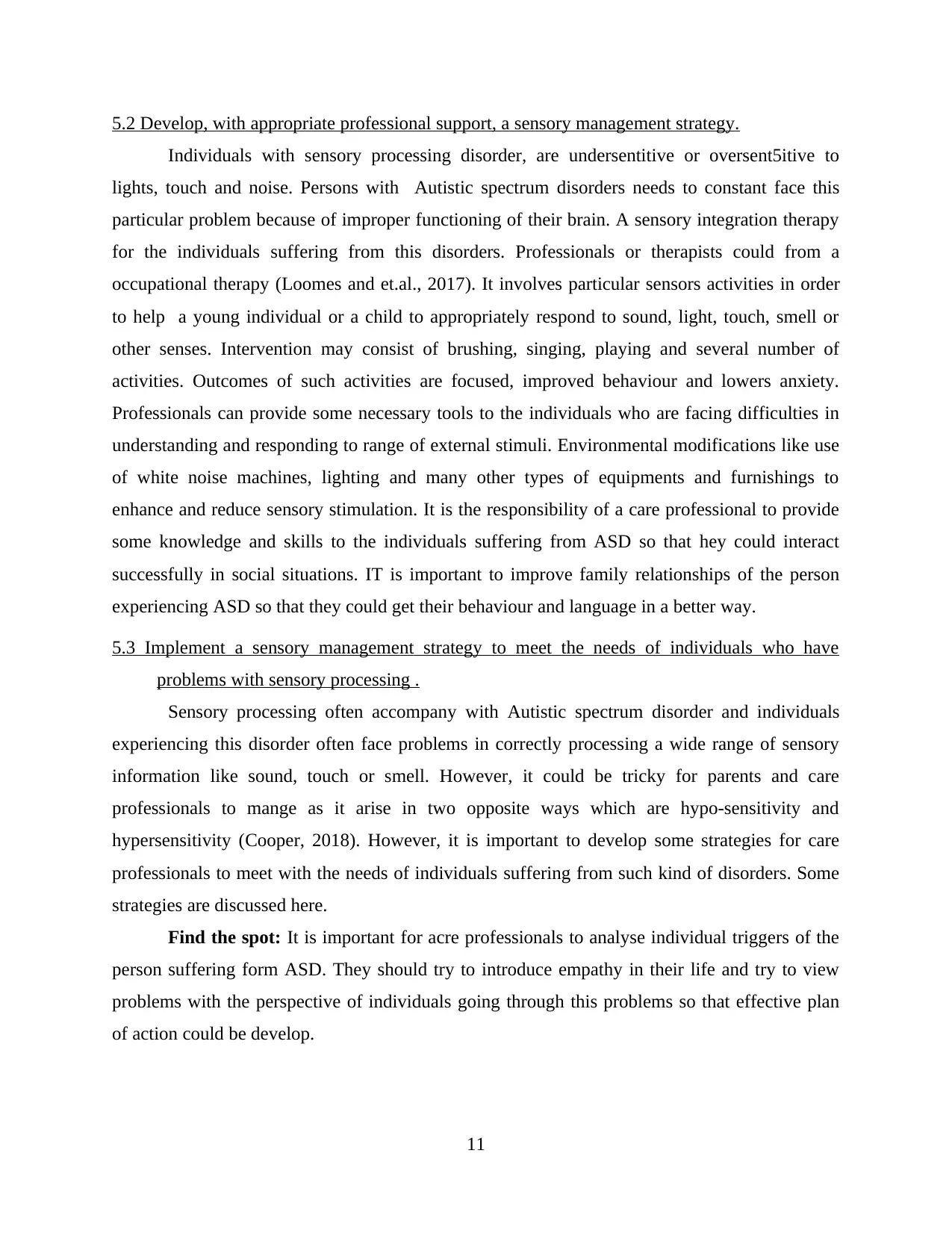
5.2 Develop, with appropriate professional support, a sensory management strategy.
Individuals with sensory processing disorder, are undersentitive or oversent5itive to
lights, touch and noise. Persons with Autistic spectrum disorders needs to constant face this
particular problem because of improper functioning of their brain. A sensory integration therapy
for the individuals suffering from this disorders. Professionals or therapists could from a
occupational therapy (Loomes and et.al., 2017). It involves particular sensors activities in order
to help a young individual or a child to appropriately respond to sound, light, touch, smell or
other senses. Intervention may consist of brushing, singing, playing and several number of
activities. Outcomes of such activities are focused, improved behaviour and lowers anxiety.
Professionals can provide some necessary tools to the individuals who are facing difficulties in
understanding and responding to range of external stimuli. Environmental modifications like use
of white noise machines, lighting and many other types of equipments and furnishings to
enhance and reduce sensory stimulation. It is the responsibility of a care professional to provide
some knowledge and skills to the individuals suffering from ASD so that hey could interact
successfully in social situations. IT is important to improve family relationships of the person
experiencing ASD so that they could get their behaviour and language in a better way.
5.3 Implement a sensory management strategy to meet the needs of individuals who have
problems with sensory processing .
Sensory processing often accompany with Autistic spectrum disorder and individuals
experiencing this disorder often face problems in correctly processing a wide range of sensory
information like sound, touch or smell. However, it could be tricky for parents and care
professionals to mange as it arise in two opposite ways which are hypo-sensitivity and
hypersensitivity (Cooper, 2018). However, it is important to develop some strategies for care
professionals to meet with the needs of individuals suffering from such kind of disorders. Some
strategies are discussed here.
Find the spot: It is important for acre professionals to analyse individual triggers of the
person suffering form ASD. They should try to introduce empathy in their life and try to view
problems with the perspective of individuals going through this problems so that effective plan
of action could be develop.
11
Individuals with sensory processing disorder, are undersentitive or oversent5itive to
lights, touch and noise. Persons with Autistic spectrum disorders needs to constant face this
particular problem because of improper functioning of their brain. A sensory integration therapy
for the individuals suffering from this disorders. Professionals or therapists could from a
occupational therapy (Loomes and et.al., 2017). It involves particular sensors activities in order
to help a young individual or a child to appropriately respond to sound, light, touch, smell or
other senses. Intervention may consist of brushing, singing, playing and several number of
activities. Outcomes of such activities are focused, improved behaviour and lowers anxiety.
Professionals can provide some necessary tools to the individuals who are facing difficulties in
understanding and responding to range of external stimuli. Environmental modifications like use
of white noise machines, lighting and many other types of equipments and furnishings to
enhance and reduce sensory stimulation. It is the responsibility of a care professional to provide
some knowledge and skills to the individuals suffering from ASD so that hey could interact
successfully in social situations. IT is important to improve family relationships of the person
experiencing ASD so that they could get their behaviour and language in a better way.
5.3 Implement a sensory management strategy to meet the needs of individuals who have
problems with sensory processing .
Sensory processing often accompany with Autistic spectrum disorder and individuals
experiencing this disorder often face problems in correctly processing a wide range of sensory
information like sound, touch or smell. However, it could be tricky for parents and care
professionals to mange as it arise in two opposite ways which are hypo-sensitivity and
hypersensitivity (Cooper, 2018). However, it is important to develop some strategies for care
professionals to meet with the needs of individuals suffering from such kind of disorders. Some
strategies are discussed here.
Find the spot: It is important for acre professionals to analyse individual triggers of the
person suffering form ASD. They should try to introduce empathy in their life and try to view
problems with the perspective of individuals going through this problems so that effective plan
of action could be develop.
11
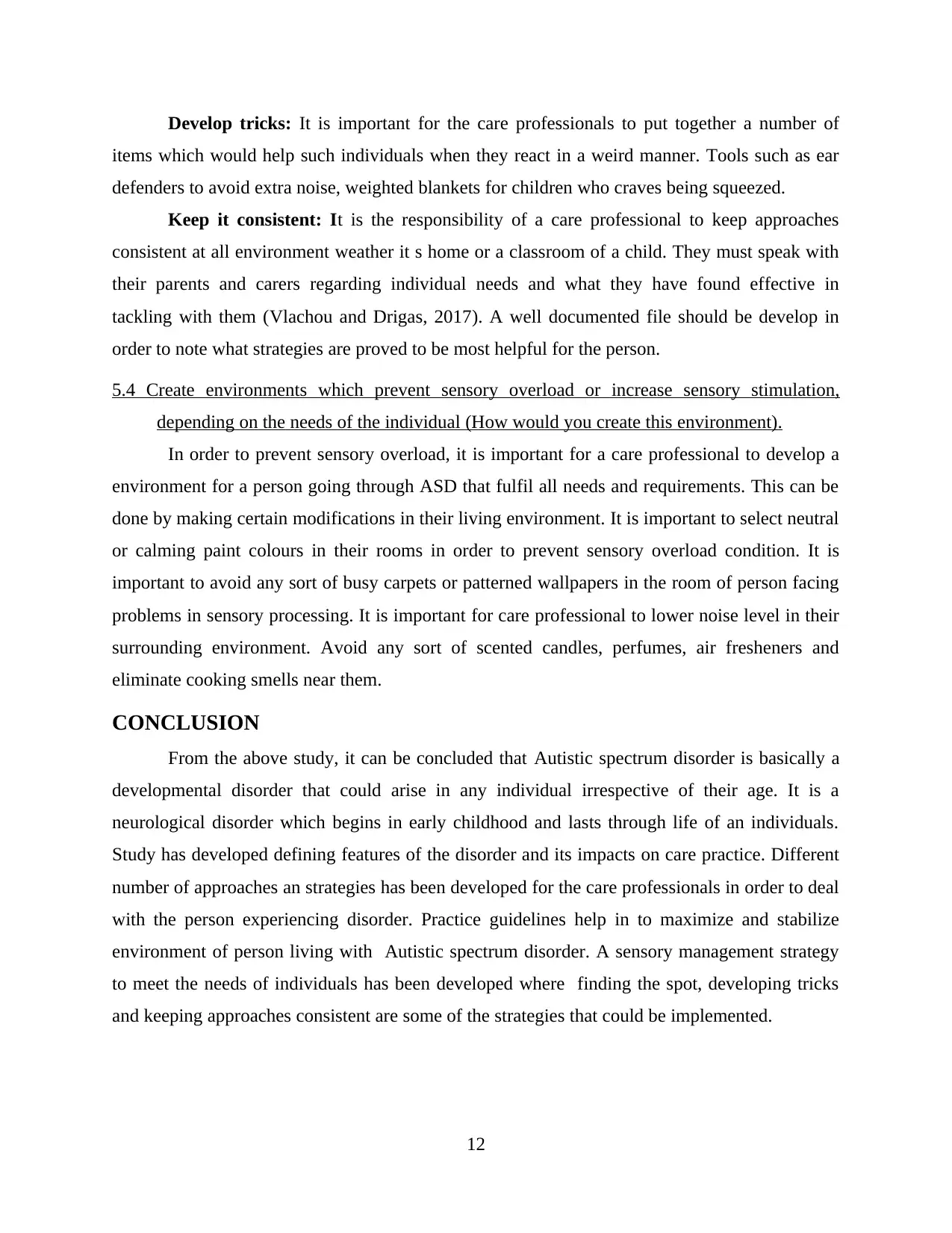
Develop tricks: It is important for the care professionals to put together a number of
items which would help such individuals when they react in a weird manner. Tools such as ear
defenders to avoid extra noise, weighted blankets for children who craves being squeezed.
Keep it consistent: It is the responsibility of a care professional to keep approaches
consistent at all environment weather it s home or a classroom of a child. They must speak with
their parents and carers regarding individual needs and what they have found effective in
tackling with them (Vlachou and Drigas, 2017). A well documented file should be develop in
order to note what strategies are proved to be most helpful for the person.
5.4 Create environments which prevent sensory overload or increase sensory stimulation,
depending on the needs of the individual (How would you create this environment).
In order to prevent sensory overload, it is important for a care professional to develop a
environment for a person going through ASD that fulfil all needs and requirements. This can be
done by making certain modifications in their living environment. It is important to select neutral
or calming paint colours in their rooms in order to prevent sensory overload condition. It is
important to avoid any sort of busy carpets or patterned wallpapers in the room of person facing
problems in sensory processing. It is important for care professional to lower noise level in their
surrounding environment. Avoid any sort of scented candles, perfumes, air fresheners and
eliminate cooking smells near them.
CONCLUSION
From the above study, it can be concluded that Autistic spectrum disorder is basically a
developmental disorder that could arise in any individual irrespective of their age. It is a
neurological disorder which begins in early childhood and lasts through life of an individuals.
Study has developed defining features of the disorder and its impacts on care practice. Different
number of approaches an strategies has been developed for the care professionals in order to deal
with the person experiencing disorder. Practice guidelines help in to maximize and stabilize
environment of person living with Autistic spectrum disorder. A sensory management strategy
to meet the needs of individuals has been developed where finding the spot, developing tricks
and keeping approaches consistent are some of the strategies that could be implemented.
12
items which would help such individuals when they react in a weird manner. Tools such as ear
defenders to avoid extra noise, weighted blankets for children who craves being squeezed.
Keep it consistent: It is the responsibility of a care professional to keep approaches
consistent at all environment weather it s home or a classroom of a child. They must speak with
their parents and carers regarding individual needs and what they have found effective in
tackling with them (Vlachou and Drigas, 2017). A well documented file should be develop in
order to note what strategies are proved to be most helpful for the person.
5.4 Create environments which prevent sensory overload or increase sensory stimulation,
depending on the needs of the individual (How would you create this environment).
In order to prevent sensory overload, it is important for a care professional to develop a
environment for a person going through ASD that fulfil all needs and requirements. This can be
done by making certain modifications in their living environment. It is important to select neutral
or calming paint colours in their rooms in order to prevent sensory overload condition. It is
important to avoid any sort of busy carpets or patterned wallpapers in the room of person facing
problems in sensory processing. It is important for care professional to lower noise level in their
surrounding environment. Avoid any sort of scented candles, perfumes, air fresheners and
eliminate cooking smells near them.
CONCLUSION
From the above study, it can be concluded that Autistic spectrum disorder is basically a
developmental disorder that could arise in any individual irrespective of their age. It is a
neurological disorder which begins in early childhood and lasts through life of an individuals.
Study has developed defining features of the disorder and its impacts on care practice. Different
number of approaches an strategies has been developed for the care professionals in order to deal
with the person experiencing disorder. Practice guidelines help in to maximize and stabilize
environment of person living with Autistic spectrum disorder. A sensory management strategy
to meet the needs of individuals has been developed where finding the spot, developing tricks
and keeping approaches consistent are some of the strategies that could be implemented.
12
⊘ This is a preview!⊘
Do you want full access?
Subscribe today to unlock all pages.

Trusted by 1+ million students worldwide
1 out of 14
Related Documents
Your All-in-One AI-Powered Toolkit for Academic Success.
+13062052269
info@desklib.com
Available 24*7 on WhatsApp / Email
![[object Object]](/_next/static/media/star-bottom.7253800d.svg)
Unlock your academic potential
Copyright © 2020–2025 A2Z Services. All Rights Reserved. Developed and managed by ZUCOL.




